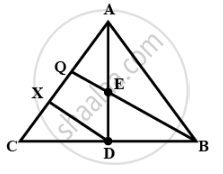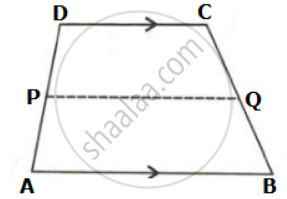Advertisements
Advertisements
Question
In ∆ABC, E is the mid-point of the median AD, and BE produced meets side AC at point Q.
Show that BE: EQ = 3: 1.
Solution

Construction: Draw DX || BQ
In ΔBCQ and ΔDCX,
∠BCQ = ∠DCX ...(Common)
∠BQC = ∠DXC ...(Corresponding angles)
So, ΔBCQ ∼ ΔDCX ....(AA Similarity criterion)
⇒ `"BQ"/"DX" = "BC"/"DC" = "CQ"/"CX"` ...(Corresponding sides are proportional.)
⇒ `"BQ"/"DX" = "2CD"/"CD"` ...(D is the mid-point of BC)
⇒ `"BQ"/"DX" = 2` ...(i)
Similarly, ΔAEQ ∼ ΔADX,
⇒ `"EQ"/"DX" = "AE"/"ED" = 1/2` ...(E is the mid-point of AD)
That is `"EQ"/"DX" = 1/2` ...(ii)
Dividing (i) by (ii), We get
⇒ `"BQ"/"EQ" = 4`
⇒ BE + EQ = 4EQ
⇒ BE = 3EQ
⇒ `"BQ"/"EQ" = 3/1`
APPEARS IN
RELATED QUESTIONS
ABCD is a rhombus, EABF is a straight line such that EA = AB = BF. Prove that ED and FC when produced meet at right angles
The figure, given below, shows a trapezium ABCD. M and N are the mid-point of the non-parallel sides AD and BC respectively. Find:

- MN, if AB = 11 cm and DC = 8 cm.
- AB, if DC = 20 cm and MN = 27 cm.
- DC, if MN = 15 cm and AB = 23 cm.
In parallelogram ABCD, E is the mid-point of AB and AP is parallel to EC which meets DC at point O and BC produced at P.
Prove that:
(i) BP = 2AD
(ii) O is the mid-point of AP.
In ΔABC, BE and CF are medians. P is a point on BE produced such that BE = EP and Q is a point on CF produced such that CF = FQ. Prove that: A is the mid-point of PQ.
Prove that the figure obtained by joining the mid-points of the adjacent sides of a rectangle is a rhombus.
In a right-angled triangle ABC. ∠ABC = 90° and D is the midpoint of AC. Prove that BD = `(1)/(2)"AC"`.
Show that the quadrilateral formed by joining the mid-points of the adjacent sides of a square is also a square.
In the given figure, ABCD is a trapezium. P and Q are the midpoints of non-parallel side AD and BC respectively. Find: PQ, if AB = 12 cm and DC = 10 cm.
Side AC of a ABC is produced to point E so that CE = `(1)/(2)"AC"`. D is the mid-point of BC and ED produced meets AB at F. Lines through D and C are drawn parallel to AB which meets AC at point P and EF at point R respectively. Prove that: 3DF = EF
D, E and F are respectively the mid-points of the sides AB, BC and CA of a triangle ABC. Prove that by joining these mid-points D, E and F, the triangles ABC is divided into four congruent triangles.
